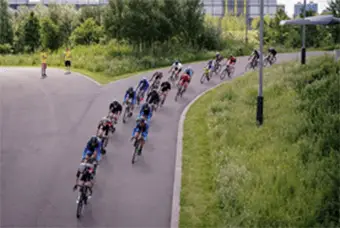
One of the biggest pleasures of road riding is the social part. That may come as no surprise, yet not every budding cyclist has a good sense of what group rides are about.
For the uninitiated, group riding may seem inaccessible. Knowing how to find group rides can be a challenge. Plus, like any other practice, group rides come with a lot of rules, most of which are unspoken.
Knowing what to expect will allow you to find the right ride, to assimilate more easily, and to avoid committing faux pas. Knowing how to operate with an appropriate group will allow you to experience one of the best parts of road riding.
Table of Contents
Finding Group Rides
Riding solo gets old. But maybe you don’t have any friends that are into cycling who can tell you about local rides. Solution: search for a local group ride. Where to look?
- Local bike shop. Not every worker at the local bike shop is an avid road cyclist. But there’s a good chance that some of them are or that they know the local scene. If they don’t know, there’s a good chance they’ll send you in the right direction. Most workers at bike shops are enthusiastic in some way about biking and want to help. Some bike shops have regular rides leaving from their door.
- Facebook groups. A local ride may have a Facebook page with all the needed information.
- Reddit. Various possibilities exist on Reddit. For example, Houston, Texas, has r/bikehouston; L.A. has r/BikeLA. Post a question about group rides on such subs, and you’ll probably get answers. Less specific but still a possible source, is something on a citywide subreddit. For example, a post on r/Denver about group rides may yield mile high gold.
- Strava. The cycling app Strava allows users to find groups in their area. Groups have chat sections where you can message a group to gather information; someone may choose to reply. This Strava feature is not currently the most robust—though Strava has set it up pretty well—yet some groups may be very responsive, so it’s worth a try.
- Local clubs. Some local clubs have many organized rides per week, not to mention other social events. With 100s of members and a dizzying number of weekly group rides, Cycling Kansas City, for example, is a great city resource. This club has a very organized calendar of rides, each with details on the particular ride.
- Internet search for your town. There are probably various pages around your town that list information for group rides. The main problem with these is that they tend not to be updated and can have incomplete information. If you find information on a web page or blog, it’s probably a good idea to get confirmation before starting to make 30 friendship bracelets to distribute.

Selecting the Right Ride
A ride must fit your needs and abilities. The person just getting into cycling who shows up at the 25 mile per hour, 40 mile drop ride won’t have a good experience.
No-drop
First, a no-drop ride is best for newbies. No-drop means that if you fall behind or if you get stuck at the traffic light, the group won’t leave you behind. Leaving people behind might sound heartless, but there are spirited rides where everyone’s intent on hammering; drift off the back or get stuck at an intersection and you’ll be left behind—there’s no looking back. It’s not fun to try a new group and find yourself going solo on mile two.
Pace
Most rides listed online will specify a pace. Through word of mouth, if someone doesn’t volunteer what speed the ride goes, ask. What pace is right for you? To some extent, you’ll discover this through trial and error. Err on the conservative side at first. You should be able to go two to four miles per hour faster than a brisk pace, or tempo ride, solo.
Distance
Most groups ride the same, or similar, routes every week. Know your limits and choose carefully. Work your way up if you wish. Don’t be overambitious and end up either holding a group back or doing the last 15 miles alone, possibly through unfamiliar territory.
Your kind of people
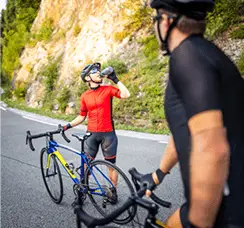
Although you won’t know this until you try it, a specific ride might not have the right vibe for you. You may feel a little alienated just because you’re an outsider—they all have cool nicknames like T-Time, Chico Nacho, Backpack Bob, the Sheriff, Sprinkles, and Hot Yoga—but force yourself to go back a few times and get to know the group.
It’s natural to feel nervous showing up to a ride for the first time if you don’t know anyone. Also, rides do change based on who shows up, so you can’t necessarily judge a ride based on one experience.
On the other hand, maybe the group just isn’t right for you. All they talk about is triathlon training; or they don’t talk; or they’re seashell collectors who cycle and you hate seashells; etc. Find a new group.
Rules of the Road
Learning how to ride in a group is learning a new culture. Every group has its own variation on the standard rules. Watch and learn. Spend the first few rides observing the group and learning how things are done. Once you get the hang of group riding, joining a new group is much easier but still requires observing a specific group’s way of doing things. Being predictable and conforming is the name of the game. Because of safety, there’s no place for rebels here.
If you want to follow your own rules, buy a mountain bike or save it for solo rides.
Distance for drafting
One thing that is fun about group rides is that you actually work as a unit. It’s all about the draft.
Those on the front are doing “the work” and those behind benefit from the draft. By drafting you ride around 30% more efficiently. In order to draft, your front wheel has to be within three feet of the rider in front’s back wheel. It doesn’t take much imagination to realize what will happen if your front wheel overlaps with the other rider’s wheel—yes, you may crash. So this takes some practice to develop a comfort level. Keep it steady and remember: there’s also someone close behind you!

Taking pulls
When you’re drafting in back, you may think the pace of the group isn’t that fast. Then you get on the front. Suddenly your heart rate shoots up. When you get tired enough, you peel off and go to the back.
The trick is to know when you’ve done a good turn but have enough strength to stick to the back of the pack when you drift back. Knowing this balance is something group ride newbs don’t excel at. First of all, you don’t need to get on the front. There are almost no group rides where people will resent unseasoned riders for not taking turns on the front. And avoid getting on the front on your first few group rides, unless you’re a quick study AND the pace is moderate. Get a sense first of how well you can keep up—and how easily you can finish the ride.
After doing the ride a few times, if you deem you’re strong enough to do a pull, then give it a try. Keep in mind there is no prize given for doing the longest pull or for doing a pull exactly as long as the last person. What is annoying is if you get on the front and slow down or speed up the pack. You want to keep the group going at about the same speed. If you can’t keep the speed up, then don’t get on the front; if you keep taking the pace up, find a faster ride. Depending on the pace and attitude of the ride, when on the front, you’re usually working hard enough that talking becomes difficult.
Someone who doesn’t want to take pulls can stick on the back of a group and let riders coming off the front slip in, in front of him. An alternative method is to go to the back at every intersection where there’s a slowdown.
If you find yourself about to get on the front, if the pace isn’t too fast on a flat, you can pull off to the side, slow down, then drift to the back. If the pace is fast or you’re on an uphill, this move can be obnoxious because someone behind you might be at their limit and suddenly they have to close a gap. Therefore, it’s probably better to pull off the front right after the person on the front ahead of you pulls off, being careful not to run into them on the way to the back.
Pulling off the front
When you’re ready to come off the front, pull off to the side, THEN slow down. If you slow down first, then pull to the side, you cause an accordion effect behind you and may cause a crash. This is a classic newbie move and may lead to broken bones, broken bikes, and hatred. Don’t do it.
Some groups, while single file, have the person in front pull off left, some pull off right. If there’s a double pace line, chances are the person on the left will pull off left, the person on the right will pull off right. Signaling when you’re ready to come off the front is also helpful. A flick of the elbow is pretty universal; some groups do a slap on the butt (sounds weirder than it is!). Watch to see what the practice is and follow it.
Catching on in the back
When you pull off the front, you drift back gradually. If the pack passes you quickly, it’s going to be hard to latch onto the back. Or if you start increasing your speed after there’s a gap at the back, you might have difficulty covering the distance.
Coordinate this and you’ll be ok. If you don’t, it may be bye bye pack, and you have to ride home alone, or you can hope that some generous person will go back and throw you a lifeline, allowing you to draft behind them to catch back up.
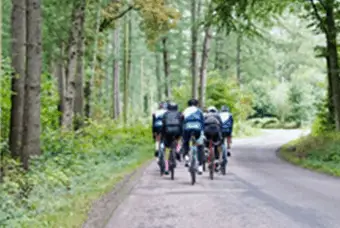
Pointing out and calling out obstacles and vehicles
When riding behind someone, visibility becomes poor. You invest trust with those ahead.
When you’re ahead, your responsibility goes up. It’s up to those in front to point out holes, cracks, rocks, and branches on the road. If there’s a parked car or pedestrian up ahead, you have to signal that as well.
If you’re not comfortable taking your hand off the handlebars to do this, unfortunately using your voice doesn’t have the same effect. Yelling “Walker up!” works; one assumes the walker is ahead and to the right. But yelling “Hole!” is less helpful because, well, where is the hole? If you’re not comfortable pointing, become comfortable. Practice. Riders that don’t call out road obstacles can cause those behind to crash or to flat.
Sprints
Some groups have designated sprints. Be ready for these as you may feel like a perfectly orderly ride has descended, on a dime, into chaos. It’s probably not a good idea to follow the sprints on the first couple times on a ride—both because you don’t know the rules, like where you’re sprinting to, for this group’s particular sprints and because you might get too exhausted.
Also, some groups’ mid-ride breakaways feel like sprints and you don’t want to jump on these without knowing what’s happening or without knowing if you can handle it.
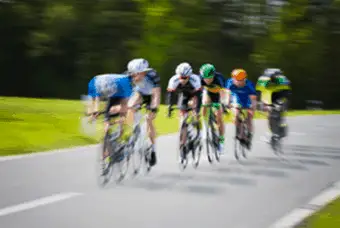
Turning
Get better at turning. Some group rides are bedeviled by scared, incompetent turners.
The group ride I usually go on has only one turn where you might need to brake. You can pedal through every turn on the route but this one. But a lot people are skittish about turning at speed and let a gap open—sometimes large—every turn.
Learn how to turn better by practicing on your own. Doing a group ride with racers makes one appreciate how smooth a ride can be when everyone knows how to handle their bike. No-drop rides will usually be forgiving to people with poor turning skills. Get behind an incompetent turner at the back of a pack on a drop ride, and you may end up riding home with your new friend.
Traffic signals
Different groups have different types of respect for traffic signals. Learn a group’s protocol at intersections—which may differ at busier intersections—and follow it. If you feel like a group isn’t safe, don’t ride with them. Also, watch out for yourself. If someone jumps across an intersection, don’t assume it’s safe to follow. It’s easier to feel no pressure in such a situation on a no-drop ride.
The route
Another reason to play it cautious the first few times on a ride: you don’t know the route! Most groups will clearly signal turns. If you’re confident enough to get on the front—and the ride is double file—you can always ask the person next to you where the next turn is. If it’s single file and you’re up front, good luck! Learn the route. Knowing generally where a ride goes is also a good idea in case you aren’t able to keep up and have to find your way back alone.
Rotating paceline
Most group rides will go double file and single file with the riders on the front pulling off and drifting all the way to the back. Some rides—usually with veteran riders or with racers—may shift part way through to a constant rotation of double file lines, with one line always moving gradually back and the other line always moving gradually up, and with the person on the front and the one on the back moving over from one line to the next. It’s good to be aware of this atypical mode in case you find yourself in the midst of it suddenly mid-ride.
Bad Group Riding Etiquette: Examples of What NOT To Do
Becoming a solid member of a group ride requires being aware of what you don’t know and being aware of what others are doing. It also requires a suppression of the ego.
There’s the rider who likes to camp out between the two riders ahead, which means the person he is next to likely has to move over from the ideal drafting spot. (If there’s a cross wind, riders will sometimes move a little to a side to get the ideal draft; that’s not what this annoying rider is doing!)
This morning I rode with an oblivious person who isn’t entirely new to group rides. Although he isn’t a strong rider relative to the pace of the group, he was, while in the middle of the pack, lagging six feet behind the wheel in front of him—yet keeping steady.
This is baffling as it’s more tiring—there’s no draft in this position—plus he was messing up the order of the pack.
Then, for no apparent reason, he would drift two feet to the left (yes, toward traffic) for stretches, and just hold it steady, then move back into his original position. Then he got on the front. And he decided to socialize the whole time and slowed the entire pack down as he wasn’t paying attention to speed. Next, he was braking on every turn, even while on the front, which is both unsafe and shows poor skills. If someone like this wants to participate in a group ride, they should remain at the back where they can do their own thing and not force others to do their own thing with them.
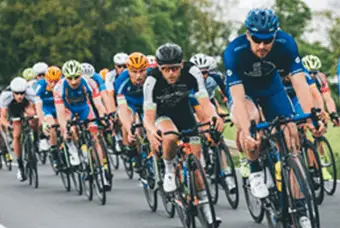
Roll ‘em!
It seems like there’s a lot to know, but most people pick it up fast. Given that riders are going 18 to 30 mph or more, all the rules and practices fall under two categories: safety and being able to stick with the ride. When both of those goals are reached, then you can get to the bigger goals of socializing, getting fitter, and having fun.
Being in a pack that works together as a unit makes cycling different—and to many, more exciting—than other fitness or leisure activities. If you’re tired of rolling around by yourself or with a friend, seek out a local group road ride and see why it’s different. Just remember to learn the rules and give it a chance!

Trevor is an experienced road and mountain biker. He has mountain biked in many of the top places in the world, including Moab, Utah; Fruita, Colorado; Bend, Oregon; Durango, Colorado; Bentonville, Arkansas; Copper Harbor, Michigan; Lake Tahoe, California; amongst others.
